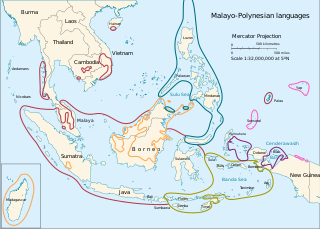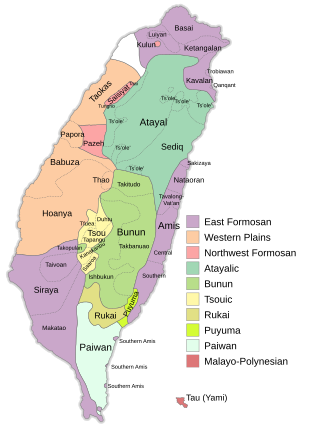
The Austronesian languages are a language family widely spoken throughout Maritime Southeast Asia, parts of Mainland Southeast Asia, Madagascar, the islands of the Pacific Ocean and Taiwan. They are spoken by about 386 million people. This makes it the fifth-largest language family by number of speakers. Major Austronesian languages include Malay, Javanese, Sundanese, Tagalog (Filipino), Malagasy and Cebuano. According to some estimates, the family contains 1,257 languages, which is the second most of any language family.

The Malayo-Polynesian languages are a subgroup of the Austronesian languages, with approximately 385.5 million speakers. The Malayo-Polynesian languages are spoken by the Austronesian peoples outside of Taiwan, in the island nations of Southeast Asia and the Pacific Ocean, with a smaller number in continental Asia in the areas near the Malay Peninsula, with Cambodia, Vietnam and the Chinese island Hainan as the northwest geographic outlier. Malagasy, spoken in the island of Madagascar off the eastern coast of Africa in the Indian Ocean, is the furthest western outlier.

Batanes, officially the Province of Batanes, is an archipelagic province in the Philippines, administratively part of the Cagayan Valley region. It is the northernmost province in the Philippines, and the smallest, both in population and land area. The capital is Basco, located on the island of Batan.

The Formosan languages are a geographic grouping comprising the languages of the indigenous peoples of Taiwan, all of which are Austronesian. They do not form a single subfamily of Austronesian but rather up to nine separate primary subfamilies. The Taiwanese indigenous peoples recognized by the government are about 2.3% of the island's population. However, only 35% speak their ancestral language, due to centuries of language shift. Of the approximately 26 languages of the Taiwanese indigenous peoples, at least ten are extinct, another four are moribund, and all others are to some degree endangered.

The Ivatan language, also known as Chirin nu Ivatan, is a Philippine language of Austronesian origins spoken in the Batanes Islands of the Philippines.

The Tao people are an Austronesian ethnic group native to the tiny outlying Orchid Island of Taiwan. They have a maritime culture, with great ritual and spiritual significance placed on boat-building and fishing. Their ways of life have been threatened by the continued emigration to the mainland of Taiwan in search of jobs and education. As a result, the continuation of past traditions has been hindered. Despite being linked to both other Taiwanese indigenous peoples and Batanic indigenous Filipino populations, the Tao people remain unique in their customs and cultural practices.

The Philippine languages or Philippinic are a proposed group by R. David Paul Zorc (1986) and Robert Blust that include all the languages of the Philippines and northern Sulawesi, Indonesia—except Sama–Bajaw and a few languages of Palawan—and form a subfamily of Austronesian languages. Although the Philippines is near the center of Austronesian expansion from Formosa, there is little linguistic diversity among the approximately 150 Philippine languages, suggesting that earlier diversity has been erased by the spread of the ancestor of the modern Philippine languages.

The Malayic languages are a branch of the Malayo-Polynesian subgroup of the Austronesian language family. The most prominent member is Malay, which is the national language of Brunei, Singapore and Malaysia, and is the basis for Indonesian, the national language of Indonesia. The Malayic branch also includes the local languages spoken by ethnic Malays, further several languages spoken by various other ethnic groups of Sumatra, Indonesia and Borneo. The most probable candidate for the urheimat of the Malayic languages is western Borneo.

The Ivatan people are an Austronesian ethnolinguistic group native to the Batanes and Babuyan Islands of the northernmost Philippines. They are genetically closely related to other ethnic groups in Northern Luzon, but also share close linguistic and cultural affinities to the Tao people of Orchid Island in Taiwan.
Proto-Austronesian is a proto-language. It is the reconstructed ancestor of the Austronesian languages, one of the world's major language families. Proto-Austronesian is assumed to have begun to diversify c. 4000 BCE – c. 3500 BCE in Taiwan.
The Austro-Tai languages, sometimes also Austro-Thai languages, are a proposed language family that comprises the Austronesian languages and the Kra–Dai languages.
The Greater North Borneo languages are a proposed subgroup of the Austronesian language family. The subgroup covers languages that are spoken throughout much of Borneo, as well as parts of Sumatra and Java, and Mainland Southeast Asia. The Greater North Borneo hypothesis was first proposed by Robert Blust (2010) and further elaborated by Alexander Smith. The evidence presented for this proposal are solely lexical.
The Northwest Sumatra–Barrier Islands languages are a group of Malayo-Polynesian languages spoken by the Batak and related peoples in the interior of North Sumatra and by the Nias, Mentawai people, and others on the Barrier islands off the western coast of Sumatra, Indonesia.

The East Formosan languages consist of various Formosan languages scattered across Taiwan, including Kavalan, Amis, and the extinct Siraya language. This grouping is supported by both Robert Blust and Paul Jen-kuei Li. Li considers the Siraya-speaking area in the southwestern plains of Taiwan to be the most likely homeland of the East Formosan speakers, where they then spread to the eastern coast of Taiwan and gradually migrated to the area of modern-day Taipei.
Proto-Malayo-Polynesian (PMP) is the reconstructed ancestor of the Malayo-Polynesian languages, which is by far the largest branch of the Austronesian language family. Proto-Malayo-Polynesian is ancestral to all Austronesian languages spoken outside Taiwan, as well as the Yami language on Taiwan's Orchid Island. The first systematic reconstruction of Proto-Austronesian ("Uraustronesisch") by Otto Dempwolff was based on evidence from languages outside of Taiwan, and was therefore actually the first reconstruction of what is now known as Proto-Malayo-Polynesian.
The Mamanwa language is a Central Philippine language spoken by the Mamanwa people. It is spoken in the provinces of Agusan del Norte and Surigao del Norte in the Lake Mainit area of Mindanao, Philippines. It had about 5,000 speakers in 1990.

Luilang, or ambiguously Ketagalan, was a Formosan language spoken south of modern-day Taipei in northern Taiwan by one of several peoples that have been called Ketagalan. The language probably went extinct in the mid-20th century and it is very poorly attested.

Babuyan Island is the highest and northernmost island in the Babuyan Islands in Luzon Strait north of Luzon Island in the Philippines and also directly south of Taiwan via Bashi Channel to Luzon Strait. The whole island makes up the barangay of Babuyan Claro, that constitute the municipality of Calayan in Cagayan province. The volcanic island has a population of 1,910 as of the 2020 census, up from 1,423 in 2010.

The Itbayat language or Itbayaten is an Austronesian language, in the Batanic group, spoken on Itbayat Island in the Batanes Islands, Philippines.
Yami language, also known as Tao language, is a Malayo-Polynesian language spoken by the Tao people of Orchid Island, 46 kilometers southeast of Taiwan. It is a member of the Ivatan dialect continuum.












